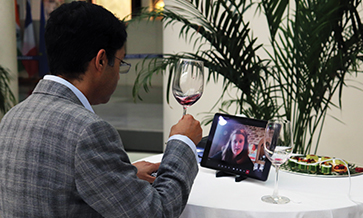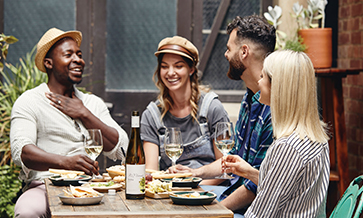Brews & Spirits Consulting Editor, Vikram Achanta, had the opportunity to catch up with Ravi Viswanathan, Chairman and main investor, at the launch of the refurbished Grover Zampa Vineyards near Nandi Hills: Excerpts:
Do you think the Indian market needs some kind of a cultural phenomenon to take it to the next level?
Like you said, yes, in Japan there was a manga (Japanese graphic novel) called ‘Drops of the Gods’ that changed the scene drastically in favour of wine there. And yes, in the US the popularity of Pinot noir can be attributed to the movie Sideways.
But I don’t know if you can look for a particular trigger point in India. I think we are now at the beginning of the exponential phase. The same thing happened in China about 25 years ago.
Consumption was then the same as in India today. It moved from one spoonful per capita per year to three bottles per capita per year. I think that in 25 years we will have a market here as big as China is today.
What could lead to that do you think?
The quality of domestic wines is improving rapidly in India, compared to the wines that were available a few years ago. What we produce now is more than fairly decent. At the top end we make extraordinary wines.
Skill sets have improved, as has the understanding of terroir. Most of the Indian wineries have world standard equipment. So all of this is already happening.
The cultural change I see is that now women are driving the growth. Indian women are not drinking spirits, especially brown spirits. You never see them with whisky in public; but you see them with wine and champagne, and you see now that wine is served almost at every wedding.
All the good restaurants now have wine. Maybe 10 or 20 years ago it was extremely rare. Now everywhere you go in the country there is wine. The fact that we and others around us are multiplying wine tourism initiatives helps people get more comfortable with wine.
Another good sign for me was a tipping point a few years ago, when consumption at home overtook (in volumes) consumption in restaurants. For the longest of times wine used to be driven by consumption in restaurants. This is a good sign.
It means that wine is coming home. People are drinking wine at home, or are drinking when you invite a friend, which is exactly what we need.
The one thing I’m convinced is that the Indian middle class, which is our core target, is much more westernised than its Chinese counterpart. For the Chinese the West is still alien. When they travel overseas they travel in groups with a guide.
Indians don’t travel in groups. They travel alone, or with families. Indians are far more comfortable with the West because they speak English and we watch the same shows now on Netflix and Amazon. So there’s a familiarity with the West, which means that picking up habits like wine drinking will come quicker.
You’ve taken big steps with your stake in Grover Vineyards and the subsequent acquisitions of Four Seasons, Charosa and Myra Vineyards.
We are exaggerating only a little bit, but the idea is that we are building wineries and adding capacities for a market that doesn’t exist yet, in the hope that in about 4 years it will be there. And all that I see points in that direction; so we’re not waiting for the market to be there.
Do you think India should focus on one particular style of winemaking?
Some grapes do well in India, some don’t. Merlot doesn’t do very well; Cabernet Franc is difficult; Viognier and Chenin are doing very well; Syrah is doing well; and Tempranillo surprisingly is doing very well in India.
We are planting dozens of varietals right now to test them. It’s enough for small quantities, so we’ll see what works and what doesn’t work. The era of Shiraz and Cabernet for red and Viognier and Sauvignon for white, that’s over. I think people want diversity. They want different styles. They want different varietals.
Will your recent acquisitions of multiple wineries take different paths?
The idea is to preserve the uniqueness of each of those wineries in terms of wine styles, with a central organisation that will handle sales, research, accounting and all that. But the individual wine styles would be preserved. The idea is not to do Grover’s everywhere. You continue to do Charosa, you continue to do Four Seasons with their own wine styles.
Will there be more focus or specialisation, say for a Myra?
Myra is more for the young, the Millennials, and also for derivative products like wine coolers or a fizzy sparkling wine. Charosa is clearly our New World brand with New World style and New World varietals.
What is the export vision for the brand?
Grover exports about 15% of its production. We want to increase that, but without losing the focus on the Indian market. The idea is not to do a Chile, which exports 90% of what it produces.
About 15% is good, because it gives us visibility overseas for brand building. It’s also good for the Indian consumer to realise that our wines are everywhere in the world. We tend to think of imported products as being better.
If you look at the imported brands (Jacob’s Creek, Hardy’s, Yellow Tail) we are in many more Michelin-star restaurants around the world than them. The people who know, the chefs and the sommeliers around the world, are responsible for this.
If you go to a three-star Michelin restaurant in Paris, you’ll find our wines. There’s a Michelin-star restaurant in Burgundy where we are the only non-Burgundy wine!
What would you say to Indian restaurateurs about Indian wine?
Certainly the restaurants contribute to that. If you go to Paris, Rome, Milan, you look at the wine lists, 80-90 % of the wine list is local. You go to the best five Indian restaurants in Bengaluru and Delhi, 15% of the wine list is Indian – if you’re lucky!
A good Indian restaurant or modern progressive Indian cuisine restaurant should have at least 50% of its wine coming from India.
When we blind-taste Indian wine – and I’m not talking only about Grover’s – it is comparable in quality to an imported wine, which is thrice the price. So it makes no sense for Indian restaurants to have wine lists dominated by foreign wines.
Wine goes with food. In France, the chefs support French wines, and the same happens in Italy and in Spain. We want our chefs to support our wine. You can even build a full wine list with Indian wines.













